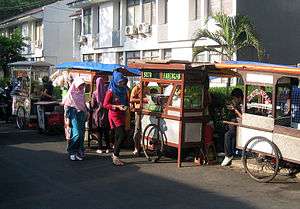Food cart


A food cart is a mobile kitchen that is set up on the street to facilitate the sale and marketing of street food to people from the local pedestrian traffic. Food carts are often found in large cities throughout the world and can be found selling food of just about any variety.
Food carts come in two basic styles. One allows the vendor to sit or stand inside and serve food through a window. Another uses all of the room inside the cart for storage and to house the cooking machinery, usually some type of grilling surface. The cart style is determined principally by the type of food served at the cart.
Food carts are different from food trucks because they do not travel under their own power. Some food carts are towed by another vehicle, while some alternatively are pushed by a human or animal or bicycle.
Portland, is now home to many food cart "pods".[1] These groups of food carts can have a few options, or span entire city blocks. Some of the most popular food cart pods offer a great selection of craft beer.
History

The first food carts probably came into being at the time of the early Greek and Roman civilizations, with traders converting old hand-carts and smaller animal-drawn carts into mobile trading units. Carts have the distinct advantage of being able to be moved should a location not be productive in sales, as well as transporting goods to/from storage to the place chosen from which to trade.
However, the use of carts exploded with the coming of the railways. Firstly, highly mobile customers required food and drink to keep them warm within the early open carriages. Secondly locomotives needed to stop regularly to take on coal and water, and hence allow their passengers use the toilets, eat and drink. Thirdly, few early trains had any form of buffet or dining car. Finally, when passengers did arrive at their destination, or at a point when they needed to switch trains or modes of transport, some refreshment was required, particularly for poorer passengers who could not afford to stay in the railway-owned hotels. This expansion lead to a mutually successful relationship, with some of the first concession stands and laws developing from mobile traders operating from restricted railway property. This form of concession based operation can be seen still in many countries, but at its most original in the under developed stations and infrastructure of Africa and Southeast Asia.
The railways also brought another benefit: a plentiful supply of new suitably sized carts. Often traders requiring new carts would simply buy old railway station luggage carts and adapt them to serving food, knowing that these were sized/scaled to fit in between the necessary doors and lifts.
Today the size and scale of carts has generally increased, and most are towed behind 4x4 vehicles. But hand towed food carts are still a common site where access is restricted and hungry people can be found.
Modern food carts
In the 21st century, innovations have included modular designed carts made with stainless steel, fiber reinforced plastic and aluminum. Some have been developed with the ability to be driven by themselves.[2]
Some food carts are associated with restaurants. Most of the food served from the cart is the same as the food in the restaurant.[3]
Portland's food carts
In the United States, the city of Portland, Oregon, has experienced a boom in the number of food carts, trailers and stands.
A 2001 report in The Oregonian stated Portland was home to 175 carts, with fierce competition for the four cart spaces available since 1987 in the South Park Blocks.[4][5] A bidding war in February 2001 led for a combined price of $192,000 for the spaces.[4] There was also a large cluster, often referred to as a food cart pod, at Fifth and Stark street, and one food cart had been running since 1980.[5] In 2010 it was estimated that there are between 450 and 671 carts citywide.[6][7][8] Cartopia is another food cart pod located on the corner of SE 12th Avenue and Hawthorne Boulevard in Southeast Portland. One of these Portland food carts includes The Grilled Cheese Grill.
See also
References
- ↑ Burmeister, Brett. "Map of Food Carts in Portland". Food Carts Portland. Retrieved 4 August 2015.
- ↑ "New food cart concept". Archived from the original on October 22, 2013. Retrieved 2009-06-28.
- ↑ "Yale Daily News - Food carts: A boon to parent restaurants?". Archived from the original on 2008-04-05. Retrieved 2008-04-13.
- 1 2 Thompson, Courtenay (2001-03-23). "PSU Food Cart Bidding Battle Mystifies, Stings". The Oregonian. pp. C02.
- 1 2 Heinz, Spencer (2001-04-09). "Taste the World, One Cart at a Time". The Oregonian. pp. B01.
- ↑ "21 top time-saving cities". CNN. March 15, 2010.
- ↑ About cartattack, cartattack.org
- ↑ "Small Fries Unite!". The Portland Mercury. January 19, 2012.
External links
| Wikimedia Commons has media related to Food carts. |
- "Inside the underground economy propping up New York City's food carts" by Jeff Koyen, Crain's New York Business, 12 June 2016

